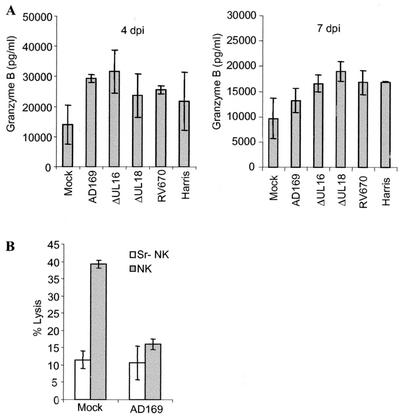FIG. 3.
HCMV-infected cells trigger the release of granzyme B. (A) To analyze whether HCMV-infected cells delivered inhibitory signals to NK cells, the amount of granzyme B was measured in the supernatant after cocultivation of NK cells with uninfected or infected target cells. The presence of granzyme B in the supernatants obtained from NK cells incubated with target cells infected with the different HCMV strains compared to uninfected cells is shown for 4 and 7 dpi. The bars represent the mean values ± standard errors of the means. (B) To examine whether NK cells lyse fibroblast mainly by using the granule pathway and not the Fas-FasL interaction, NK cells were treated with strontium (Sr) (which causes degranulation of the NK cells) prior to the NK cell lysis test. While Sr-treated NK cells exhibited a reduced ability to kill uninfected cells compared to untreated NK cells, the susceptibility of HCMV-infected cells to NK lysis was not affected. Mean values ± standard deviations (n = 4) at an effector/target cell ratio of 50:1 are shown.

